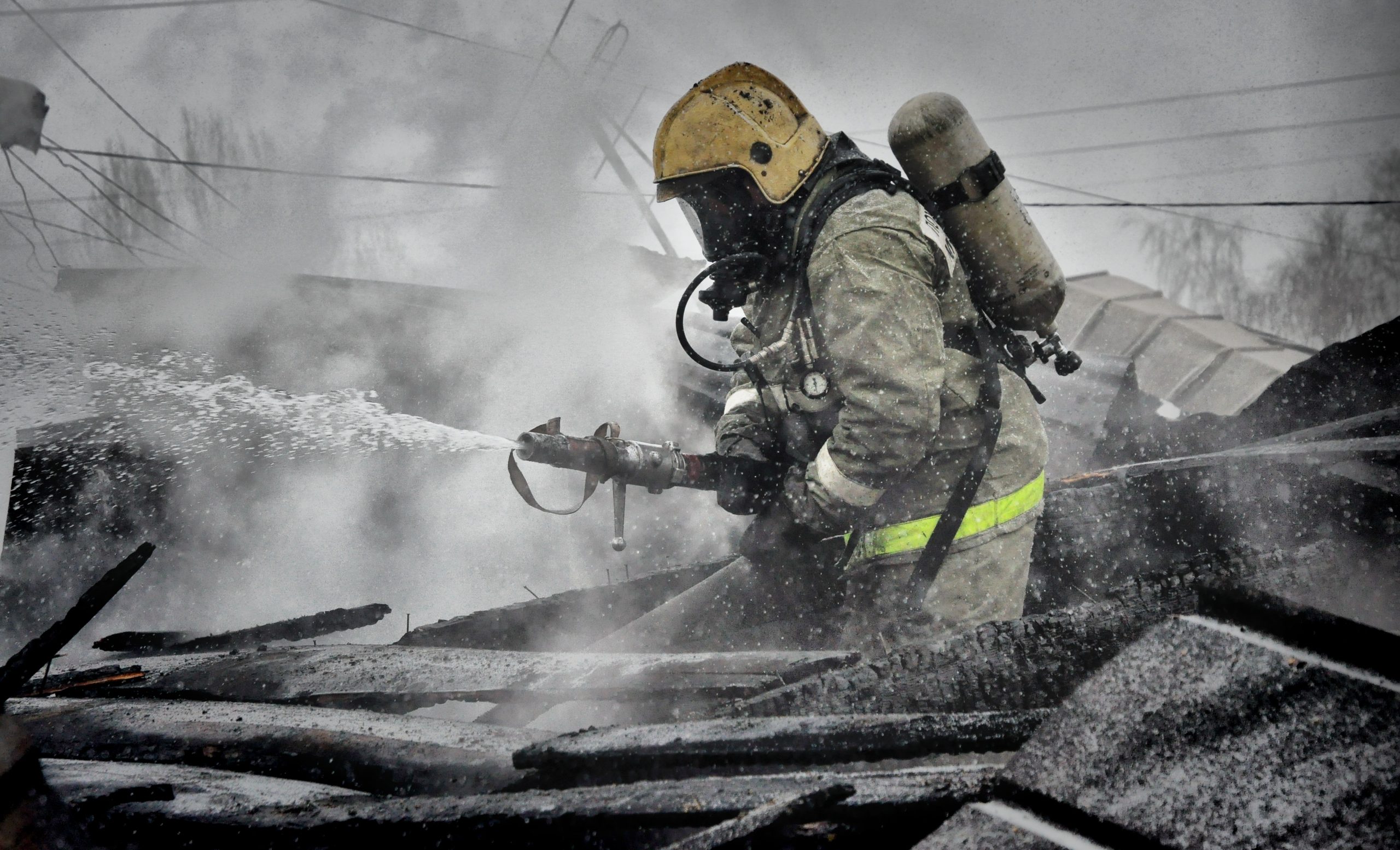
Firefighting is an inherently dangerous profession. As first responders, firefighters routinely risk their lives to protect and save others. In recent decades, advances in the technology used to fight fires and protect firefighters have ironically created a new risk for firefighters: cancer and other serious health issues. Most — and probably all — firefighters have been unknowingly exposed to dangerous cancer-causing chemicals.
Two technological advances are responsible for firefighters’ increased risk for cancer, other diseases, and health problems. The first is Aqueous Film Forming Foam (AFFF), a Class B firefighting foam used to suppress fires caused by liquid fuels, such as gasoline or jet fuel. This foam contains perfluorooctanesulfonic acid (PFOS) or perfluorooctanoic acid (PFOA), which are part of a group of chemicals known as PFAS. The second is firefighters’ turnout gear, the apparel worn during fire response and training, which is designed and manufactured to protect firefighters from direct flame contact and exposure to hazardous fluids, water, and heat — and also contains PFAS.
What Are PFAS?
PFAS are a combination of manufactured chemicals (notably PFOS and PFOA) used in myriad industrial and consumer products since the 1940s, including food packaging, nonstick cookware, furniture, carpets, stain repellent fabrics and upholstery, compost, artificial turf, and pesticides. PFAS assist in repelling water and hazardous liquids and are used in consumer products that have waterproof or water-repellent properties.
Found in a wide range of commercial, industrial, and military applications, PFAS are known as “forever chemicals” because they remain in the environment, drinking water, and the human body for extended periods of time. According to the Centers for Disease Control (CDC), PFAS are extremely persistent. These chemicals resist typical environmental degradation processes and have a typical half-life in the human body from two to nine years — the time required for half the quantity to be metabolized or eliminated from the body. The National Institute of Environmental Health Sciences reports that over time, people may take in more PFAS chemicals than they excrete, a process that leads to bioaccumulation in their bodies.
Known Dangers of PFAS
The risks of exposure are not yet fully known, but prolonged exposure to PFAS can cause kidney and other cancers, liver damage, decreased fertility, fetal development problems, immune system deficiencies, and elevated cholesterol levels and it increases the risk of asthma and thyroid disease, according to the CDC. Testicular cancer, mesothelioma, non-Hodgkin’s lymphoma, and prostate cancer — which are four of the top eight cancers detected more commonly in firefighters — have also been linked to PFAS.
Workers at increased risk for PFAS exposure at their jobs include firefighters, who are regularly exposed through AFFF and their turnout gear. Firefighters have a 9% higher chance of being diagnosed with cancer and a 14% higher risk of dying from cancer than the general U.S. population.
Exposure Pathways: How PFAS Increases Firefighters’ Health Risks
As noted earlier, AFFF and firefighters’ turnout gear are substantial sources of PFAS exposure. Because AFFF is extremely effective in fighting liquid fuel-based fires, it is used at civilian airports, military air bases, oil rigs, and refineries. It is also widely used in firefighter training, and the frequency of training increases exposure.
PFAS are present in turnout gear, which comprises three layers intended to protect firefighters: a thermal layer worn next to the skin, covered by a layer that is a moisture barrier resistant to water and other liquids, and an outer shell composed of material that is flame retardant.
A 2020 study led by University of Notre Dame Professor of Physics Graham Peaslee found high concentrations of PFAS on the moisture barrier and outer shell. Because PFAS have the ability to migrate off treated surfaces and materials, the two outer layers could potentially contaminate the thermal layer and come in direct contact with skin. The researchers expressed concern that sweat under the thermal layer could also draw PFAS into the skin, and that these chemicals have the ability to shed off the gear and transfer to other surfaces.
Manufacturers Knew of PFAS’ Dangers; U.S. Government Slow to Respond
In 1967, the U.S. Navy began requiring vessels to carry AFFF to fight fires, and during the 1970s, the Department of Defense began utilizing AFFF in virtually all military installations. By the mid-1970s, PFAS were being used in turnout gear for firefighters.
As early as 1950, studies conducted by 3M showed that PFAS could accumulate in human blood. Animal studies conducted by 3M and DuPont in the 1960s revealed PFAS’ health risks, but the companies kept the research and results secret for decades. They continued monitoring health impacts and conducting research but did not publicly acknowledge the dangers until the late 1990s.
By the early 2000s, the toxic dangers of PFAS were widely known, but for nearly 20 years, the U.S. government ignored the issue. Only recently have government regulators taken action.
The U.S. Environmental Protection Agency (EPA) recently issued new proposed rules limiting the drinking water levels for six types of PFAS to 4 parts per trillion or less — and noted that no amount of PFAS is safe. Underscoring the need for the EPA’s proposed new rules, the White House released two new reports on March 14, 2023, outlining the action plan to address PFAS contamination and steps taken to date.
Holding PFAS Manufacturers Responsible in the Courts
Litigation for water contamination and other injuries caused by PFAS through AFFF has been consolidated in a multidistrict litigation (MDL) in the U.S. District Court for the District of South Carolina, presided over by Judge Richard M. Gergel. The MDL has been in place since 2019.
Currently, the MDL consolidates over 2,000 cases of individual plaintiffs alleging personal harm and entities seeking damages for cleanup costs and other harm. More than 40 defendants have been sued in connection with the AFFF litigation to ensure that they will be held accountable for the harm they caused. The first bellwether trials are expected to begin in June 2023.
Singleton Schreiber has filed a lawsuit against 3M, DuPont, and dozens of other defendants in the MDL on behalf of Mr. Mendoza, who worked for 30 years as a firefighter, advancing from Cadet to Fire Chief. During his career as a firefighter in Winters, California, Mr. Mendoza was exposed to PFAS through AFFF in firefighting training and response exercises and used equipment and gear treated and coated with materials containing PFAS.
Mr. Mendoza was diagnosed with kidney cancer in 2016, which has been linked to exposure to PFAS found in AFFF. Mr. Mendoza’s complaint alleges that PFAS were designed, marketed, developed, manufactured, sold, and distributed by companies such as 3M and other defendants, despite the fact that these companies knew or should have known that PFAS present a cancer risk and other health risks to humans. Furthermore, the defendants have continued to conceal and withhold information from their customers, which would have alerted users to the health effects or risks associated with their use of and exposure to AFFF and products containing PFAS.
For decades, firefighters have been unwittingly exposed to these dangers and suffered the ill effects, while the manufacturers knew the risks and profited from the use of PFAS and AFFF. They must be held accountable in the courts.
If you’ve been exposed to AFFF or PFAS through your work, contact Singleton Schreiber to explore your options for seeking compensation.
- Partner
Paul Starita is Partner at Singleton Schreiber with over 29 years of experience as a trial attorney. He exclusively represents plaintiffs in catastrophic personal injury and mass tort matters in State and Federal courts.
Before ...

